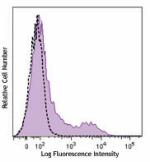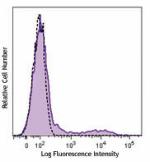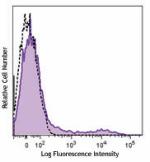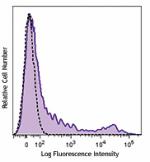- Clone
- Tü39 (See other available formats)
- Regulatory Status
- RUO
- Other Names
- MHC class II, Major Histocompatibility complex II, human leukocyte antigen, HLA
- Isotype
- Mouse IgG2a, κ
- Ave. Rating
- Submit a Review
- Product Citations
- publications
HLA-DR, HLA-DP, and HLA-DQ are heterodimeric cell surface glycoproteins comprised of an α (heavy) chain and a β (light) chain. They are expressed on B cells, activated T cells, monocytes/macrophages, dendritic cells, and other non-professional APCs. In conjunction with the CD3/TCR complex and CD4 molecules, HLA-DR is critical for efficient peptide presentation to CD4+ T cells. Variations in the HLA gene expression are crucial to graft survival.
Product DetailsProduct Details
- Verified Reactivity
- Human
- Reported Reactivity
- Baboon, Cynomolgus, Cat, Dog, Cow
- Antibody Type
- Monoclonal
- Host Species
- Mouse
- Immunogen
- Human PBL
- Formulation
- Phosphate-buffered solution, pH 7.2, containing 0.09% sodium azide
- Preparation
- The antibody was purified by affinity chromatography and conjugated with Spark Blue™ 550 under optimal conditions.
- Concentration
- 0.2 mg/mL
- Storage & Handling
- The antibody solution should be stored undiluted between 2°C and 8°C, and protected from prolonged exposure to light. Do not freeze.
- Application
-
FC
- Recommended Usage
-
Flexi-Fluors™ are provided at a standard 0.2 mg/mL concentration. We recommend titrating this reagent to determine the optimal concentration for each application. For many flow cytometry applications, conjugated antibodies perform well at concentrations ranging from 0.03 to 1.0 µg per million cells in 100 µL. We recommend testing a range of concentrations starting from 10 µg/mL.
For example, make five 1:1 serial dilutions of the 0.2 mg/mL antibody. Add 5 µL of each dilution (including the undiluted antibody) to 100 µL of cells (at 107 cells/mL) to test six concentrations -- 1.0, 0.5, 0.25, 0.125, 0.06, and 0.03 µg per million cells in 100 µL volume. Compare staining patterns or create a titration curve using the MFI or staining index to determine the optimal concentration.
* Spark Blue™ 550 has a maximum excitation of 516 nm and a maximum emission of 540 nm. - Excitation Laser
-
Blue Laser (488 nm)
- Application Notes
-
Tü39 has been reported to react with a shared epitope of HLA-DR, HLA-DP, and HLA-DQ.
Additional reported applications (of relevant formats) include immunoprecipitation6, in vitro blocking of MLR5, and suppressor cell generation4. The LEAF™ purified antibody (Endotoxin <0.1 EU/µg, Azide-Free, 0.2 µm filtered) is recommended for functional assays (contact our custom solutions team). - Additional Product Notes
-
For more information about Flexi-Fluors™, visit our Flexi-Fluor™ page and review FAQs associated with this product line.
-
Application References
(PubMed link indicates BioLegend citation) -
- Pawelec G, et al. 1985. Hum. Immunol. 12:165.
- Shaw S, et al. 1985. Hum. Immunol. 12:191.
- Ziegler A, et al. 1986. Immunobiology 171:77.
- Pawelec G, et al. 1986. Hum. Immunol. 17:343. (Block)
- Dai Z, et al. 2009. J. Exp. Med. 206:793. (Block)
- Pawelec G, et al. 1988. J. Exp. Med. 167:243. (IP)
- RRID
-
AB_3662572 (BioLegend Cat. No. 285268)
Antigen Details
- Structure
- Ig superfamily, MHC class II, heterodimeric transmembrane protein
- Distribution
-
B cells, activated T cells, monocytes/macrophages, dendritic cells, other APCs
- Function
- Antigen presentation
- Ligand/Receptor
- CD3/TCR, CD4
- Cell Type
- Antigen-presenting cells, B cells, Dendritic cells, Macrophages, Monocytes, T cells
- Biology Area
- Immunology, Innate Immunity
- Molecular Family
- MHC Antigens
- Antigen References
-
1. Thorsby E. 1974. Transplant. Rev. 18:51.
2. Qvigstad E, et al. 1984. Hum. Immunol. 11:207.
3. Servenius B, et al. 1984. EMBO J. 3:3209.
4. Ottenhoff TH, et al. 1985. Hum. Immunol. 13:105.
5. Strassmann G, et al. 1985. Hum. Immunol. 13:125.
6. Trowsdale J, et al. 1985. Immunol Rev. 85:5. - Gene ID
- 3122 View all products for this Gene ID 3123 View all products for this Gene ID 3113 View all products for this Gene ID 3115 View all products for this Gene ID 3117 View all products for this Gene ID 3119 View all products for this Gene ID
- UniProt
- View information about HLA-DR DP DQ on UniProt.org
Related Pages & Pathways
Pages
Related FAQs
- What are Flexi-Fluors?
-
Flexi-Fluors are rapidly made-to-order conjugated antibodies. The technology, manufacturing processes, and specifications used to create Flexi-Fluors are the same as our regular catalog products. However, the optimal concentration and performance of each Flexi-Fluor must be determined by the customer.
- How quickly will I receive my order?
-
We aim to ship Flexi-Fluors within 2-3 weeks of receipt of your order. However, depending on your location, shipping times may vary.
- How are Flexi-Fluors different from regular catalog products?
-
Flexi-Fluors are made on demand, specifically for you. Flexi-Fluors are manufactured using the same high-quality standards, and specifications as other catalog products. For faster delivery, Flexi-Fluors are not tested by flow cytometry to determine optimal concentrations or evaluate performance. This testing needs to be performed by the customer.
- How do I determine the optimal concentration for using my Flexi-Fluor? How should I titrate my antibody?
-
Flexi-Fluors are provided at a standard 0.2 mg/mL concentration. We recommend that you titrate your antibody to determine the optimal concentration to use for your application. For many flow cytometry applications, conjugated antibodies perform well at concentrations ranging from 0.03 to 1.0 µg per million cells in 100 µL volume. We recommend that you test a range of concentrations starting from 10 µg/mL.
For example, make five 1:1 serial dilutions of your 0.2 mg/mL antibody. Add 5 µL of each dilution (including the undiluted antibody) to 100 µL of cells (at 107 cells/ml) to test six concentrations - 1.0, 0.5, 0.25, 0.125, 0.06, and 0.03 µg per million cells in 100 µL volume. Compare staining patterns or create a titration curve using the MFI or staining index to determine the optimal concentration.
- I can’t find the antibody-dye combination that I need. When will it be available?
-
We continuously update our catalog, introducing scores of new products every month. Please get in touch with our Technical Service team for an update on new products or recommendations for suitable alternatives to complete your panel. Or contact Custom Solutions to inquire about our affordable custom conjugation services.
- I need help to validate the performance of my Flexi-Fluor. Who should I contact?
-
Please get in touch with Technical Service for assistance.
- Can I order more than 50 μg of a Flexi-Fluor?
-
Yes, you can order multiple vials of the same Flexi-Fluor products. We cannot guarantee, however, that these vials will be bottled from the same lot. For bulk single-lot orders, contact our Custom Solutions team.
- What is the expiration date of my Flexi-Fluor?
-
Expiration dates can be found on the vial label or by using our CoA lookup tool.
Other Formats
View All HLA-DR, DP, DQ Reagents Request Custom Conjugation| Description | Clone | Applications |
|---|---|---|
| Purified anti-human HLA-DR, DP, DQ | Tü39 | FC,IHC-P,IP |
| FITC anti-human HLA-DR, DP, DQ | Tü39 | FC |
| Alexa Fluor® 647 anti-human HLA-DR, DP, DQ | Tü39 | FC |
| PE/Cyanine7 anti-human HLA-DR, DP, DQ | Tü39 | FC |
| APC anti-human HLA-DR, DP, DQ | Tü39 | FC |
| PerCP/Cyanine5.5 anti-human HLA-DR, DP, DQ | Tü39 | FC |
| PE anti-human HLA-DR, DP, DQ | Tü39 | FC |
| APC/Fire™ 750 anti-human HLA-DR, DP, DQ | Tü39 | FC |
| TotalSeq™-A1018 anti-human HLA-DR, DP, DQ | Tü39 | PG |
| TotalSeq™-D1018 anti-human HLA-DR, DP, DQ | Tü39 | PG |
| TotalSeq™-B1018 anti-human HLA-DR, DP, DQ | Tü39 | PG |
| Spark Blue™ 574 anti-human HLA-DR, DP, DQ | Tü39 | FC |
| TotalSeq™-C1018 anti-human HLA-DR, DP, DQ | Tü39 | PG |
| Spark Red™ 718 anti-human HLA-DR/HLA-DP/HLA-DQ (Flexi-Fluor™) | Tü39 | FC |
| Spark Blue™ 550 anti-human HLA-DR/HLA-DP/HLA-DQ (Flexi-Fluor™) | Tü39 | FC |
| Spark PLUS UV395™ anti-human HLA-DR, DP, DQ | Tü39 | FC |
Compare Data Across All Formats
This data display is provided for general comparisons between formats.
Your actual data may vary due to variations in samples, target cells, instruments and their settings, staining conditions, and other factors.
If you need assistance with selecting the best format contact our expert technical support team.
-
Purified anti-human HLA-DR, DP, DQ

Human peripheral blood lymphocytes were stained with purifie... 
IHC staining of Purified anti-human HLA-DR, DP, DQ (clone Tü... -
FITC anti-human HLA-DR, DP, DQ

Human peripheral blood lymphocytes were stained with purifie... -
Alexa Fluor® 647 anti-human HLA-DR, DP, DQ

Human peripheral blood lymphocytes were stained with purifie... -
PE/Cyanine7 anti-human HLA-DR, DP, DQ

Human peripheral blood lymphocytes were stained with purifie... -
APC anti-human HLA-DR, DP, DQ

Human peripheral blood lymphocytes were stained with CD19 Al... -
PerCP/Cyanine5.5 anti-human HLA-DR, DP, DQ

Human peripheral blood lymphocytes were stained with CD19 Al... -
PE anti-human HLA-DR, DP, DQ

Human peripheral blood lymphocytes were stained with CD19 Al... -
APC/Fire™ 750 anti-human HLA-DR, DP, DQ

Human peripheral blood lymphocytes were stained with CD19 Al... -
TotalSeq™-A1018 anti-human HLA-DR, DP, DQ
-
TotalSeq™-D1018 anti-human HLA-DR, DP, DQ
-
TotalSeq™-B1018 anti-human HLA-DR, DP, DQ
-
Spark Blue™ 574 anti-human HLA-DR, DP, DQ

Human peripheral blood lymphocytes were stained with anti-hu... -
TotalSeq™-C1018 anti-human HLA-DR, DP, DQ
-
Spark Red™ 718 anti-human HLA-DR/HLA-DP/HLA-DQ (Flexi-Fluor™)
-
Spark Blue™ 550 anti-human HLA-DR/HLA-DP/HLA-DQ (Flexi-Fluor™)
-
Spark PLUS UV395™ anti-human HLA-DR, DP, DQ

Human peripheral blood lymphocytes were stained with anti-hu...












Follow Us